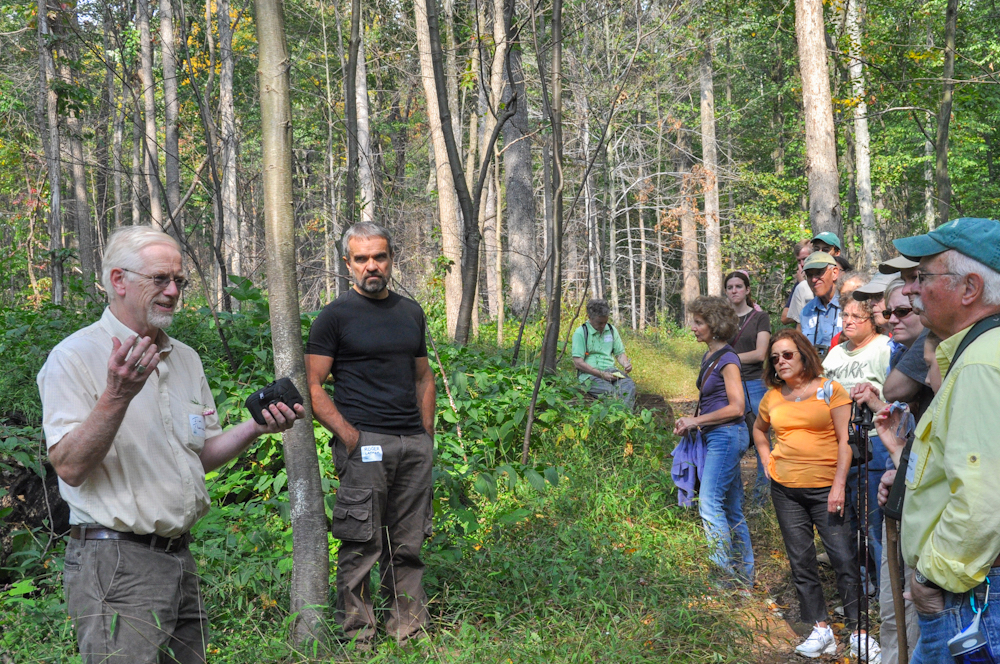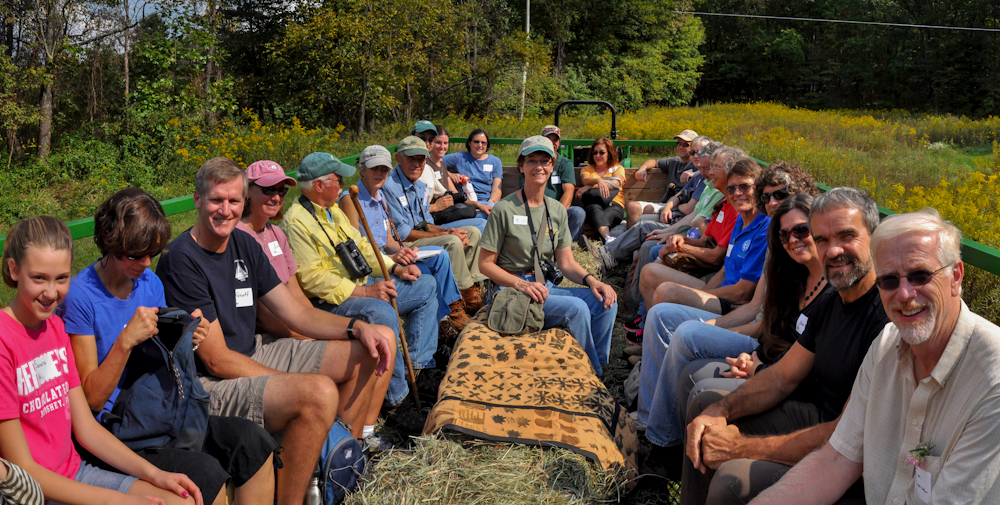In memory of Dr. Jim Thorne, Conservation Scientist
By Daniel Barringer, Preserve Manager.
The conservation world last month lost a gentleman and scientist who greatly aided our stewardship mission at Natural Lands and other organizations. Dr. James Thorne, or Jim as we knew him, passed away December 31, 2020 at age 69.

Dr. Jim Thorne with Dr. Roger Latham leading a 2012 tour in the woods in French Creek State Park that had burned in the Hopewell Fire.
Jim came to us from The Nature Conservancy and brought science into our stewardship work. At Crow’s Nest alone there were four significant projects that would not have happened without him: he created a demonstration site for oak regeneration, he created the conditions under which we could legitimately continue doing prescribed fire, he found the funding for and set in motion our prescribed grazing for habitat management, and he spearheaded the formation of the Hopewell Big Woods, a coalition to promote conservation in the largest remaining forested areas of southeastern Pennsylvania.
Much of his work had to do with the effects of fire on forests, and our eastern forests today are profoundly influenced by Indigenous peoples’ use of fire, and the changes to fire regimes following the clearing of those forests during European settlement and then by subsequent forest succession and fire exclusion. The oak-dominated forests of our region, once thought to be simplistically “the climax forest,” are now considered to be fire-influenced communities and today, shade-intolerant oaks are giving way to maple-beech forest communities in the absence of fire. Jim set out to demonstrate what a stand might look like following the introduction of a few techniques intended to encourage oaks’ access to sunlight, reintroduce fire, and simultaneously create conditions closer to the uneven-aged stands associated with older-growth forests. It was an ambitious project carried out on a few acres of Crow’s Nest Preserve, and involved thinning some of the competing trees by removing them or girdling them, introducing prescribed fire (in 2008), and fencing portions from deer to encourage seedling regeneration. In a pattern consistent with all his work described here, Jim raised the money for the project, located graduate students to carry out the work and collect the data; we benefitted from the management without it greatly increasing our workload. The project site is a little off the beaten path at Crow’s Nest but I continue to take graduate students and interns to see this section of forest and compare it to adjacent, non-treated forest.
Jim Thorne also led the initiative to professionalize and legitimize the use of prescribed fire in Pennsylvania. Along with Preserve Manager Darin Groff, Jim was instrumental in the formation of the Pennsylvania Prescribed Fire Council. The Council established standards for training, procedures for documenting and carrying out prescribed fire at the highest level of safety so that the Pennsylvania Legislature would approve of its use. I think it’s safe to say that the prescribed fire program at Natural Lands would not look at all the same without Jim.
Jim also turned his attention to another kind of habitat management, the use of animals for what we call prescribed grazing. Along with fire, the use of animals for managing land is one of the oldest methods humans used and is also today one of the trendiest techniques. Jim got there early on, locating funding for fencing and securing permits to use cattle and goats to control weeds and other competing vegetation. Today we are still maintaining the practices here at Crow’s Nest in what we consider to be state-of-the art management for specific habitats.

Dr. Jim Thorne, lower right, leading our “Fire & Ice (Cream)” program, 2012.
The photos here show Jim co-leading an event we held in September, 2012, where we took a hayride to see the areas the burned in a wildfire in French Creek State Park in April of that year. The vegetation was responding vigorously to the disturbance of the fire, and Jim, along with Dr. Roger Latham, were able to put these changes in perspective for the attendees. We ended the trip with ice cream, hence the event name, “Fire and Ice.”
Perhaps Jim’s best-known accomplishment is the formation of the Hopewell Big Woods partnership. This group brings together conservation organizations, agencies, and local officials in an effort to protect and promote the forests in the area around Crow’s Nest Preserve, French Creek State Park, Hopewell Furnace National Historic Site, Warwick County Park, Birdsboro Waters, and many other private and public lands that make up this area which serves as a link to the Pennsylvania Highlands.
It’s worth repeating here what the ambitious and thoughtful goals are for the Hopewell Big Woods, formulated in a process that took months to identify and refine:
The permanent protection and stewardship of at least 15,000 acres of unbroken forest in and around French Creek State Park.
The conservation of water quality and quantity in the watersheds of the Upper Reaches of French Creek, the entirety of Hay Creek and the other smaller watersheds within the Hopewell Big Woods. The primary indicator for watershed conservation is retaining impervious cover below 6% in these watersheds.
The conservation of state and federally listed and other rare species, occurring within the Hopewell Big Woods.
The promotion of the recreational resources located in and around the Hopewell Big Woods.
The encouragement of compatible economic development within the Hopewell Big Woods that is consistent with the other conservation goals
The protection of historic and other cultural resources occurring within and nearby the Hopewell Big Woods.
Jim was effective and bringing together people with many different interests who still meet regularly and share what they’re doing, cooperate on projects, and help each other with their own organizations’ goals. You can see a video on the Hopewell Big Woods website of Jim narrating a helicopter flight over the area that shows off its many features.
More than anything, I’ll remember Jim for his agreeable nature. If you’d ask him if it was possible to do some project, he’d get a glint in his eye and say, “Yeah, we can do that.”
We’ll miss you, Jim.
